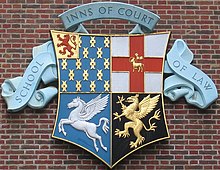Inns of Court

The four English bar associations for the lawyers ( barristers ) who are allowed to plead in court are called Inns of Court . The term also refers to those building complexes in London , England that have housed these chambers since the 14th century. In 1882 the main building of the Royal Courts of Justice was built in its immediate vicinity .
function
Inn (or hospitium ) in this context means a town house or a pension, especially in the original period a pension for students. Court referred to the court, more precisely the court of justice. The term Inns of Court refers not only to the buildings, but also to the institutions located in them, the bar associations.
Any lawyer in England who is allowed to appear in court must be a member of one of these bar associations. The chambers have a controlling and disciplinary function. But they also provide libraries, dining options and exclusive overnight and work rooms. Each of the chambers is assigned its own church or chapel. Since the end of the 20th century, many lawyers have moved outside the area in London or other major cities due to lack of space.
There were numerous chambers in earlier centuries, four of which remain.
The four bar associations are called:
- The Honorable Society of the Inner Temple
- The Honorable Society of the Middle Temple
- The Honorable Society of Gray's Inn
- The Honorable Society of Lincoln's Inn
history
Since the Norman conquest , it was reserved for clerics in England to deal with legal matters or to speak justice at court .
A law of Edward I in 1292 was decisive for the separation of ecclesiastical and secular law, because in this law the two professions of barrister and solicitor , as they are called today, were placed under the supervision of secular judges and ended their supremacy of the clergy who previously represented this role at the king's court. Training centers were now needed for the lay people , which led to the establishment of the Inns of Court in the early 14th century.
In addition to taking over the property on land and buildings of the Templars (i.e. Middle Temple and Inner Temple ) between Thames and Fleet Street , numerous other building complexes in the City of London were converted or newly built as living, dining and classrooms for the a growing stratum of secular legal scholars and their students who were organized in a similar way to e. B. the study facilities at Oxford and Cambridge .
The Great Fire of London in 1666 and other fires and bombings during World War II destroyed many of the Inns of Court buildings . Nevertheless, some things have been preserved or have been reconstructed, so that the flair of the story has been preserved. a. is often used as a film set.
Since 1852 the bar associations ( Inns of Court ) no longer serve for the training of legal scholars or at most have a supporting function. Most of the rooms are now used by barristers and ordinary lawyers who may a. Help newcomers to make contacts and advise them on their first cases.
From the 16th to the 19th centuries, in addition to the Inns of Court, there was also the Doctors' Commons , in which lawyers specially trained in canonical and Roman law were organized. These were exclusively approved for representation before the ecclesiastical and admiralty courts .
Membership and organization
There are three classes of legal scholars:
- The Masters (called Masters of the Bench , Masters or Benchers ), mainly judges or so-called Queen's Counsel (particularly experienced barristers who have been awarded this title and who are colloquially called "Silks" because of their different robes). A High Court judge must have been a barrister for at least ten years
- The lawyers who are allowed to plead in court ( barristers ) and
- The newcomers to the profession ( students ) who want to learn more through contacts.
The lawyers who are not allowed to plead in court ( solicitors ) do not belong to the chambers, but are allowed to use the buildings of the Inns of Court .
Each chamber complex is administered by a treasurer, namely the oldest associated attorney, who passes on his office after one year.
location
Reach are leading to the Inns of Court belonging chambers Middle Temple and Inner Temple , between Thames and Fleet Street are, fastest way to the subway station Temple . They are located in the City of London , but administratively have their own legal status.
Gray's Inn and Lincoln's Inn are in the London Borough of Camden (formerly the Borough of Holborn), on the border of the City of London . They do not have their own administrative status. The nearest underground station is Chancery Lane .